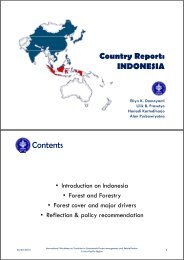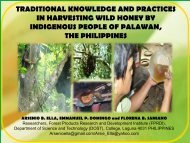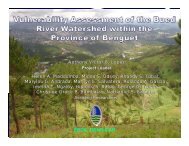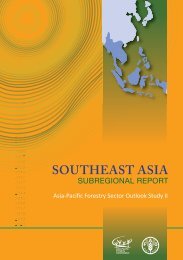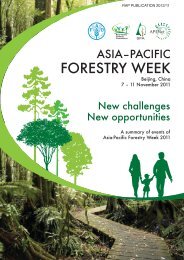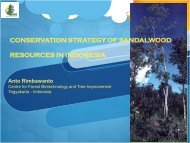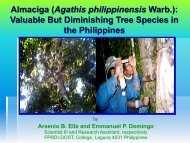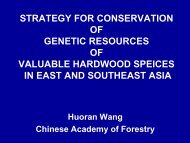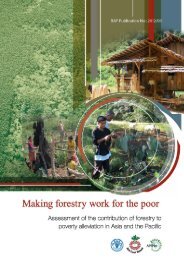Community guidelines for accessing forestry voluntary carbon ... - FAO
Community guidelines for accessing forestry voluntary carbon ... - FAO
Community guidelines for accessing forestry voluntary carbon ... - FAO
Create successful ePaper yourself
Turn your PDF publications into a flip-book with our unique Google optimized e-Paper software.
Chapter 5: Project implementation: field work<br />
source of emissions. The use of fossil fuels in project activities<br />
is particularly important, so any additional travel, extra<br />
haulage equipment or harvesting machinery must be carefully<br />
recorded. These emissions will be subtracted from the project<br />
outcome to give net emission reductions.<br />
In some <strong>for</strong>estry VCM projects, only the AGWB <strong>carbon</strong> pool needs to be<br />
measured. In this case, the skills used <strong>for</strong> <strong>for</strong>est inventory (measuring<br />
tree height, diameter, stocking density, volume etc.) will probably<br />
be sufficient to carry out the fieldwork, provided that the inventory<br />
techniques used can yield a high level of accuracy. Forest inventory<br />
techniques will also be useful <strong>for</strong> measuring some of the other <strong>carbon</strong><br />
pools. However, measuring SOC and BGB pools will require specialized<br />
skills that will need to be obtained either through training or by hiring<br />
external help.<br />
5.4 Identifying and quantifying leakage<br />
Leakage (see Glossary and Chapter 2) is an increase in GHG emissions<br />
outside of the project area due to the activities implemented inside of<br />
the project area. Project managers, staff and partners are not directly<br />
responsible <strong>for</strong> leakage and may not be able to do much about it.<br />
However, every <strong>for</strong>estry VCM standard will expect the PD or PDD to<br />
describe how leakage will be minimized, and how leakage that cannot<br />
be avoided is quantified.<br />
One of the most common <strong>for</strong>ms of leakage in <strong>for</strong>estry VCM projects is<br />
the displacement of activities such as fuel wood collection or shifting<br />
cultivation from the project area to other <strong>for</strong>ests. As <strong>for</strong>est-dependent<br />
people near the project site generally carry out these activities, one of<br />
the most important strategies to minimize leakage is local consultation.<br />
This process facilitates appropriate project design and careful site<br />
129




